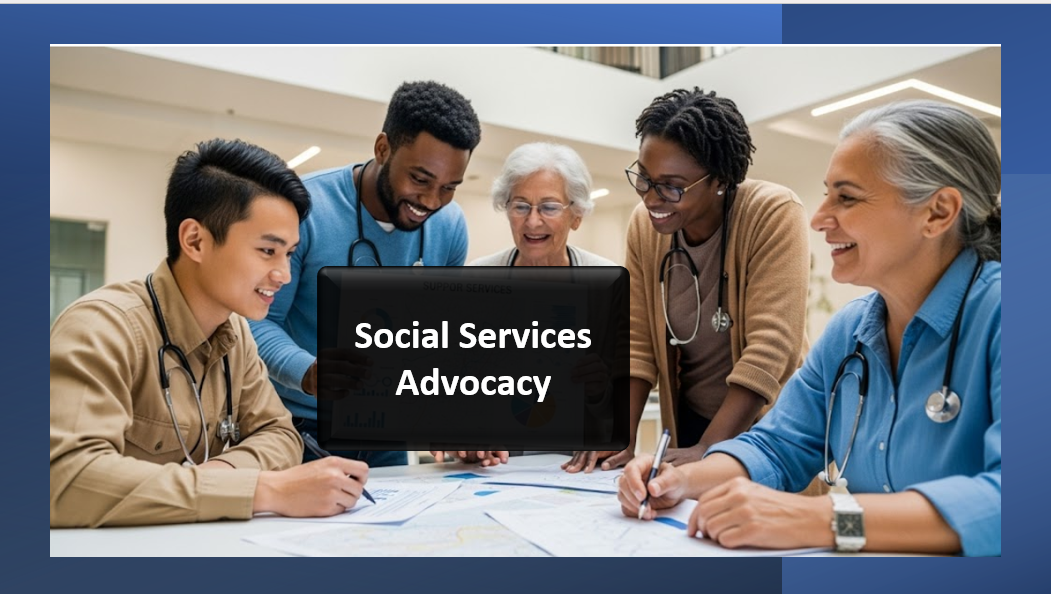Introduction: Your Guide to Becoming a Powerful Social Services Advocate
In this comprehensive guide, we’ll show you how to become a powerful voice for social change, advocate for vulnerable communities, and take practical steps toward improving the systems that shape people’s lives.
If you’re a professional looking to make a bigger impact, this article will provide you with a clear roadmap, actionable steps, and practical social services insights.
You’ll discover what social advocacy really means, explore social advocate examples that make an impact, and gain tools to start advocating today.
Imagine Maya, a dedicated social services worker who noticed a disturbing pattern: families she supported were denied access to essential benefits due to complex application barriers.

Frustrated but motivated, Maya began advocating on their behalf. She partnered with local advocacy groups, pushed for legislative changes, and successfully helped streamline access to housing support. Her role shifted from helper to changemaker, and yours can too.
To help you get started, we’ve included a free, downloadable social service advocacy checklist with practical steps and resources to guide your advocacy efforts. Whether you’re a seasoned professional or just starting out, this article will equip you with the tools you need to advocate for meaningful social change.
Pro Tip: Advocacy starts with noticing injustice and deciding not to stay silent. Start where you are.
Let’s get started
Watch this overview video or read the detailed guide below.
Table of Contents
- Understanding Social Advocacy: Definitions, Key Terms, and Meaning
- What Social Advocates Do and Why It Matters
- How to Advocate for Social Services: Roles, Examples, and Groups
- Types and Examples of Social Advocacy
- Advocating for Social Change: Strategies, Impact, and Examples
- How to Be an Effective Social Advocate
- Download Your Free Social Advocacy Checklist
- Conclusion
- Frequently Asked Questions (FAQs)
Pro Tip: Bookmark this guide and return to it after taking your first steps. Progress in advocacy comes from reflection and iteration.

Understanding Social Advocacy: Definitions, Key Terms, and Meaning
Social advocacy is the act of championing the rights, needs, and dignity of others, especially those facing systemic barriers. It involves influencing public policies, improving services, and ensuring that every individual has a fair chance to thrive.
People often ask, “What is social advocacy?” At its core, it’s about promoting justice and equity through action. Whether you’re pushing for more inclusive education, healthcare access, or disability rights, advocacy aims to create lasting change by elevating the needs of underserved populations.
Learning the meaning and definition of social advocacy helps set the foundation for effective action. It’s not just about having the right terminology, it’s about knowing how to intervene and when to speak up.
At its heart, social advocacy is the act of speaking up for and supporting the rights and needs of individuals and communities to create a more just and equitable society. It’s about taking action to influence social policy, systems, and attitudes. A social advocate is a person who champions these causes. Professionals in fields like health and social care often engage in this work daily, but they might not always recognize it as formal advocacy. The social advocate meaning extends beyond just helping one person; it’s about addressing the root causes of problems.
Common social advocacy topics include things like housing insecurity, healthcare access, and educational equity. When you engage in advocacy and social change, you are working to alter the conditions that perpetuate social issues. This can involve anything from educating the public to lobbying for new legislation. The key is to understand that your role as an advocate for social change is to amplify the voices of those who are often unheard.
Pro Tip: When explaining social advocacy to others, connect it to real-life situations they can relate to, this builds empathy and support.
What Social Advocates Do and Why It Matters
Social advocates speak up for individuals and communities who might otherwise go unheard. They navigate systems, challenge inequalities, and push for better outcomes across social services, healthcare, education, housing, and more.
You don’t need to hold a specific job title to be a social advocate. Anyone, teachers, students, caseworkers, even neighbors, can step into this role. Social service advocates often support clients directly while also identifying broader issues that need reform.
If you’ve ever helped someone access services they were denied, or raised concerns about unfair practices at work, you’ve already practiced social advocacy.
Pro Tip: Start by identifying the barriers you see every day, then ask who they harm, and how you can help remove them.
How to Advocate for Social Services: Roles, Examples, and Groups
Advocating for social services involves working to ensure individuals receive the help they need from systems that often fall short. This could include housing assistance, healthcare benefits, educational support, or food security.
You can advocate within your own workplace or join existing social advocacy organizations. These groups, such as local coalitions or national nonprofits, provide structure, training, and collective power to advance change.
Examples include caseworkers who help clients appeal service denials, community leaders who organize public health events, or volunteers who help families access food programs. Even small interventions can have major ripple effects when rooted in empathy and consistency.
Pro Tip: Partnering with local groups can fast-track your learning and expand your advocacy impact through shared goals.
Types and Examples of Social Advocacy
Social advocacy takes many forms, and understanding the different types of social advocacy is crucial for finding the approach that works best for you. The goal is always to create positive social change advocacy examples that can be replicated. One common form is direct advocacy, where you work one-on-one with individuals to help them navigate complex systems, like an advocate for social services helping a client apply for benefits. This is a foundational aspect of being a social services advocate and is highly impactful on a personal level.
Another powerful form is systemic advocacy, which addresses the root causes of social issues. This is where you work to change policies and practices at a broader level. For instance, if you see a common problem affecting many clients, you might work to change the policy itself. This is often the focus of social advocacy organizations and social advocacy groups. For professionals in health and social care, understanding advocacy definition in health and social care is vital. Social advocacy examples range from a community group fighting for a new park to a national organization advocating for universal healthcare.
Pro Tip: Identify a specific type of advocacy that aligns with your strengths and resources. Whether it’s one-on-one or large-scale policy work, every effort counts.
Advocating for Social Change: Strategies, Impact, and Examples
Advocacy for social change goes beyond helping individuals, it targets the root causes of injustice. It includes raising awareness, shifting public attitudes, and influencing laws and policies.
Common social advocacy topics include affordable housing, mental health access, prison reform, racial equity, and more. Each issue requires a tailored approach, but all benefit from evidence-based storytelling, strategic partnerships, and persistence.
Some powerful examples:
- A student group that campaigns for free menstrual products on campus
- A coalition that pushes city leaders to expand homeless shelters during winter
- A health worker who testifies before a state committee about gaps in Medicaid coverage
Whether you’re writing letters, organizing petitions, or meeting with officials, your voice can drive systemic transformation.
Pro Tip: Social change takes time. Track your efforts, celebrate milestones, and share stories to keep yourself and others motivated.

How to Be an Effective Social Advocate
Becoming an effective social advocate requires more than just passion; it demands a strategic approach. It’s about knowing how to advocate social services and social change effectively. The first step is to build your knowledge base. Read up on social issues advocacy and understand the specific challenges you are tackling. Networking is also key. Connect with other social advocates and join a social advocacy organization to learn from their experience and amplify your voice.
Next, you need to develop your communication skills. A powerful social services advocate can articulate complex issues clearly and compellingly. Learn how to tell stories that highlight the human impact of social problems. This is far more effective than just presenting data. Whether you are speaking to a local community group or a state legislator, your ability to connect on a human level is your greatest asset. The roles of advocacy in social change are varied, but at their core, they all require a combination of empathy, knowledge, and strategic action.
Pro Tip: Practice your storytelling. Create a concise, powerful narrative about a person or community impacted by the issue you are passionate about. This will be your most effective tool.
Free Downloadable Social Services Advocate Checklist: Your Social Advocacy Action Plan
Ready to turn what you’ve learned into action? We’ve created a comprehensive, free downloadable checklist to help you apply the principles of effective social advocacy.
This checklist breaks down the key steps, from identifying your cause to building a network and creating your action plan, into a simple, easy-to-follow format.
It is the perfect companion to this guide, ensuring you have a practical tool to navigate your advocacy journey. Download your checklist today and start making a difference!
It includes:
- Goal-setting templates to define your advocacy focus
- A guide to mapping community resources and allies
- Steps for writing to lawmakers or starting a campaign
- Tools for evaluating impact and documenting success
- Contact tracker for outreach to media and officials
This checklist is designed for professionals, students, and community advocates alike.
📥 Download the Free Social Advocacy Checklist (PDF & Word)
Pro Tip: Use this checklist to run your first campaign, even if it’s just helping one person. Success starts with small wins.
Conclusion: Your Impactful Journey as a Social Advocate
The journey to becoming a powerful social advocate is a rewarding one. You’ve learned that a social advocate is more than just a helper, they are a catalyst for change.
By understanding the core concepts, exploring different social advocacy examples, and adopting a strategic approach, you are now equipped to make a significant impact. Remember that every action, no matter how small, contributes to the larger goal of creating a more just and equitable society. The world needs more social advocates like you.
Social advocacy isn’t reserved for experts or activists, it’s a mindset and a commitment. When you choose to speak up, take action, and stand with others, you become part of something much bigger than yourself.
Whether you’re advocating for one client or aiming to change a system, the journey is worth it. Stay curious, stay connected, and keep showing up.
Pro Tip: Never underestimate your voice. You may be the reason someone gets the support they deserve.
Frequently Asked Questions (FAQs)
What is a social advocate?
A social advocate is someone who speaks up for the rights and needs of individuals or communities, especially those facing injustice or limited access to essential services.
How do I start social advocacy if I’ve never done it before?
Begin by choosing a cause you care about. Then learn about the issue, connect with affected communities, and take your first step, whether that’s volunteering, contacting a decision-maker, or raising awareness online.
What’s an example of social advocacy in action?
One example is a group of residents campaigning for safer crosswalks in their neighborhood, resulting in city-funded infrastructure changes that improve community safety.
Do I need to work for an organization to be a social advocate?
No. While many advocates are part of organizations, anyone can advocate independently. What matters most is consistent action, not affiliation.
What types of social advocacy exist?
Types include legislative advocacy, community-based advocacy, educational campaigns, legal advocacy, and policy reform. Each has a unique role in advancing change.
What is the difference between a social advocate and a social service advocate?
A social advocate is a broad term for anyone who speaks up for a social cause. A social services advocate is a more specific role, often a professional who helps individuals and families navigate the complex systems of social services to access benefits and support they are entitled to.
What are some examples of advocacy in health and social care?
Examples of advocacy in health and social care include helping a patient understand their treatment options, assisting a family in securing home care services, or campaigning for better mental health resources in a community. These actions ensure that individuals have a voice and that their rights are protected within the healthcare and social services systems.
How can I find a social advocacy organization to join?
You can find a social advocacy organization by searching online for groups that align with your specific interests, such as environmental justice, housing, or educational equity. Many organizations, from small local nonprofits to large national groups, are always looking for volunteers and professionals who want to contribute their skills and passion to their cause.
What does a social advocate do on a daily basis?
The day-to-day activities of a social advocate vary widely depending on their role and focus. They might spend their time researching social issues, meeting with community members to discuss their needs, drafting proposals for policy changes, or speaking at public forums. In many cases, it involves a mix of direct work with individuals and broader, systemic efforts to create change.
Pro Tip: When networking, ask specific questions about a person’s advocacy journey and how they overcame challenges. This will provide you with valuable, real-world insights.
Note: Content on this website (socialworkportal.com) is copyrighted and protected under applicable copyright laws. Unauthorized reproduction, distribution, or use of any content from the website, without explicit written permission, is strictly prohibited. Read: Terms of Use.
Social Work Portal Disclaimer: Social Work Portal is not a social work agency and we do not refer social workers. This web site is provided for educational and informational purposes only and does not constitute providing medical advice or professional social and healthcare services. The information provided should not be used for diagnosing or treating a health problem or disease, and those seeking personal medical advice should consult with ... Read our full disclaimer here: Social Work Portal Disclaimer.




